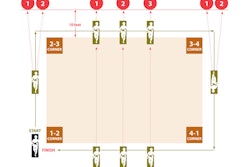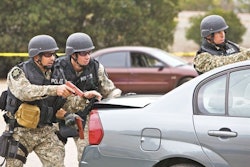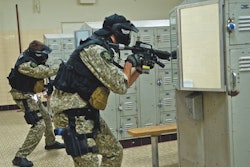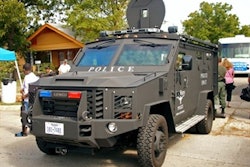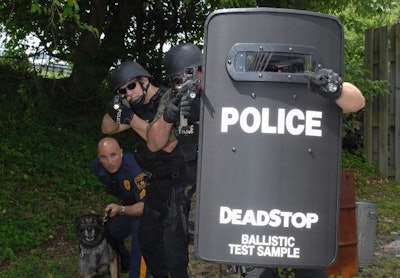 LCOA Composites' DeadStop ballistic shield. Photo: LCOA
LCOA Composites' DeadStop ballistic shield. Photo: LCOA
SWAT trainers usually yell, "Cover, Cover, Cover," to teams performing tactical training movements. Building sound operational skill may save your life; yet carrying a proper ballistic shield gives you another important safety tool.
In the past 10 years, active shooter response has changed many of the ways officers respond to critical incidents. After the Columbine High massacre, agencies began to favor dynamic entries over the "surround and call out" tactic so officers could stop the killing. When entering an armed encounter, a ballistic shield can make all the difference, as we saw earlier this month in New York City.
Let's look at what you should look for when choosing a ballistic (not bulletproof) shield.
The most common ballistic rating carried today by officers is a Level IIIA shield. Level IIIA shields handle the job and are also much more affordable than Level III or Level IV shields. As the levels go up, so does the weight, as well as the price.
More advanced tactical teams who respond to many critical incidents go with the heavier gauge shields and "bunkers" that carry wheel systems to roll down long hallways. These clearly have their place in certain scenarios.
Let's now cover the basics of the shield. First, the shield is nothing more than a form of portable cover. Remember that. It's not rated to stop rifle rounds or sniper rounds unless it's a high-level bunker unit. During a critical incident, officers deploy to the scene and if a shield is available they'll use it. Whether these officers are SWAT or patrol, the same principles apply to the arrival, deployment, and approach. Even with a shield, you'll need to find multiple cover points during the approach. Don't rely on the shield to be that saving-grace tool, especially if you're covering some ground to reach a location.
Now back to the recent hostage barricade in New York. Four members of the NYPD's Emergency Services Unit (ESU) raided an apartment in Brooklyn and exchanged gunfire with ex-con who held hostage his pregnant girlfriend and their infant son.
Nakwon Foxworth, 33, was taken into custody, after firing rounds at the officers, who suffered gunshot wounds to their legs. Once the shooter realized the officers were using shields, he aimed and fired low. The shield saved the officers' lives and a quick apprehension by the entry team kept the shooter from reaching other high-powered weapons.
When using the shield, you must still look for other cover. Don't double stack two IIIA shields to form a "6B" (IIIA + IIIA) shield. If you see a tree when moving toward danger, use it for cover and stay behind the shield. When moving down a school hallway with a shield, look for cover points. When shooting with a shield, practice, practice, practice for accuracy, stability and movement. Do not wing your training.
A shield is another tool in your tactical tool bag. Everyone should be proficient with in during movement, entry, shooting and rescue operations. Always know it is a supplemental tool, rather than a "catch all" tool.
Officer Jose Medina is an active member of the Piscataway (N.J.) Police Department's SWAT team. He is a professional trainer for Team APC training.
Related:






